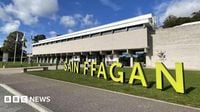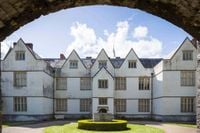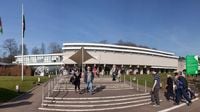In the early hours of Monday, October 6, 2025, a brazen and meticulously planned burglary shattered the tranquility of St Fagans National Museum of History, one of Wales’ most beloved heritage institutions. At precisely 12:30 AM, South Wales Police received a call from onsite security staff, reporting that two suspects had smashed their way into the museum’s main building on the leafy outskirts of Cardiff. Their target: some of the most precious artefacts in the museum’s collection—irreplaceable Bronze Age gold jewellery.
According to BBC News, the thieves executed their heist in just four minutes, focusing solely on the display case housing the prized gold artefacts in the ‘Wales is...’ gallery. CCTV footage, later described as “emotional to watch” by Jane Richardson, chief executive of National Museum Wales, captured the suspects’ unwavering focus. “They knew exactly where they were going,” she told BBC Radio Wales Breakfast. “They didn’t look left or right. It looks like they’d been scoping out in advance and that they had come for specific items.”
Within five minutes of the alarm being raised, a police helicopter hovered over the museum grounds. Despite the swift response, the thieves had already vanished into the night, taking with them items believed to include gold ingots, bracelets, and a lunula necklace—artefacts that date back to between 2300 BC and 800 BC, according to Museum Wales. The true value of these objects, as Richardson emphasized, is incalculable. “Any value would be meaningless because you can’t recreate that level of history. You can’t put a price on it. They cannot be replaced—they are so special.”
For the museum community and the people of Wales, the theft was more than a criminal act; it was a personal violation. “These items don’t belong to us at the museum, they belong to the people of Wales,” Richardson lamented. “The Amgueddfa is a family which everyone in Wales belongs to, and it feels like the family of Wales has been attacked.” The sentiment was echoed by staff and visitors alike, with local resident Sady Hurley telling BBC News, “I’m absolutely horrified and disgusted. This is our heritage, and some hooligan is prepared to ruin it. I’m beyond words.”
The museum’s overnight staff, following strict security protocols, were thankfully unharmed. “We always take security and safety very seriously—we have very strong protocols in place,” Richardson said, adding that even top-notch, specially designed display cases cannot guarantee complete security. The incident, she noted, is part of an unwelcome trend of targeted museum thefts “around the world.”
South Wales Police quickly launched a major investigation. Detective Inspector Bob Chambers, speaking to Nation.Cymru, urged the public to come forward: “Any information, no matter how small, may be relevant to the investigation.” The police provided a reference number—2500319252—for anyone able to help. By Tuesday afternoon, October 7, two men aged 43 and 50 from Northampton had been arrested on suspicion of burglary and were taken into custody in Northamptonshire, as reported by BBC News. However, the stolen artefacts remained missing, and the search for them continued.
The theft has sent shockwaves through Wales’ cultural and political circles. Heledd Fychan, Plaid Cymru Member of the Senedd for South Wales Central, called for assurances that the rest of the national collections were safe. Jane Hutt, Wales’ social justice secretary, condemned the “horrific loss” and confirmed that security had been strengthened across all Museum Wales sites in response.
The museum itself, founded in 1948 and now one of seven national museums under Amgueddfa Cymru, has long been a symbol of Welsh identity and resilience. Its open-air grounds chronicle the daily life, architecture, and culture of the Welsh people through the ages. The main building, redeveloped in a £30 million overhaul in 2018, houses some of the country’s most important historical treasures. The theft, as Richardson put it, “feels like someone has stolen from the family of Wales.”
Despite the shock, St Fagans has remained open to the public, although the main building, café, and indoor galleries are temporarily closed while the investigation continues. The museum is also hosting the Museums Association’s annual conference as planned, a testament to the resilience and determination of both staff and the wider Welsh heritage community. A spokesperson for the Museums Association told The Guardian, “We know this is a much-loved institution in Wales and internationally, and we hope that items can be recovered as soon as possible.”
The targeted nature of the crime has raised troubling questions about the future safety of museum collections. Frank Olding, an archaeologist and former curator, told BBC Wales that the stolen artefacts are so distinctive that “any dealer or anyone with any interest in history or the Bronze Age would know immediately what these objects were, and that would of course draw attention to the thieves as well.” He warned that the worst outcome would be if the gold were melted down for its raw value, destroying forever the historical information it provides. “That really would be a tragedy.”
For members of the public, the theft has sparked a mix of outrage, sadness, and concern. Adam Ackerman, a local publican, described the break-in as “unusual and concerning,” noting the ease with which the museum could be scouted out due to its open grounds and multiple entrances. Visitor Mourag Law, 75, saw the incident as a symptom of broader societal issues: “This is a reflection of a broken country and it seems to have been stolen to order. St Fagans works hard to preserve the past, and this very much deserves to be protected.”
As the investigation continues, police, museum officials, and the people of Wales remain united in their determination to recover the stolen treasures. The theft has not only deprived Wales of precious artefacts but has also prompted a renewed focus on the security and stewardship of the nation’s cultural heritage. For now, the hope remains that the artefacts will be returned and that the story of Wales, as told through its ancient gold, can continue to inspire future generations.






